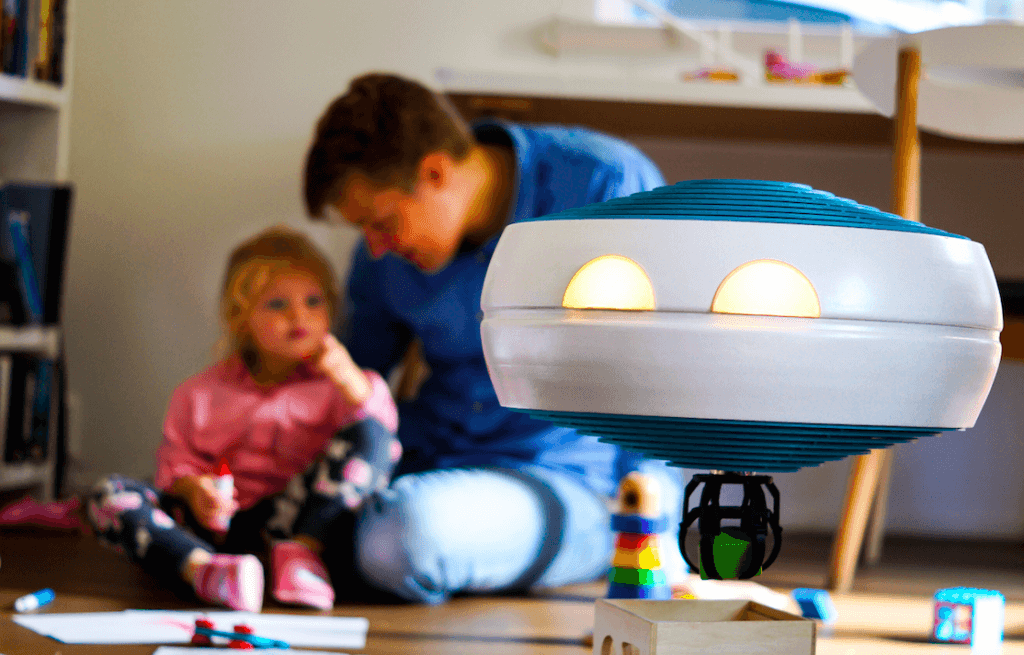
The university celebrates its 60th birthday – a good occasion for Lex Hoefsloot and Tessie Hearts – both as a student active in the anniversary committee – to organize “something special”. “We wanted to show something cool and actually arrived fairly quickly at the idea of an indoor drone that can do something useful,” said Hartjes of BlueJay Eindhoven.
 A drone we know primarily as an outside toy. “Those two characteristics we questioned when we started to work on our project in September. We wanted to go inside and we wanted to show something useful.” The core of the concept was a drone that can perform a task without causing damage in a confined space with people. “And it should be able to pick up something.”
A drone we know primarily as an outside toy. “Those two characteristics we questioned when we started to work on our project in September. We wanted to go inside and we wanted to show something useful.” The core of the concept was a drone that can perform a task without causing damage in a confined space with people. “And it should be able to pick up something.”
Soon all sorts of questions came up, because even with such a sharp idea you can go in any direction. Hartjes: “How do you give a drone command, with your voice or otherwise? A sign for example? How do you communicate at all?” If the drone is to perform very precise tasks inside a room, coordination is extremely important. “Inside there is little room for error,” Hoefsloot adds. “The drone should find its own way through the room and very accurately determine its position.”
The first purpose of team BlueJay is to develop a drone which is useful. Hoefsloot: “Therefore we have focused on things such as fire safety, intrusion security, helping disabled people and help in production, right from the start. The fundamental question for the moment is primarily whether we should focus on developing just one application that could very well be done by the drone, or working on a platform that has the potential to do a lot of tasks.”
Hartjes is a student in Innovation Sciences, Hoefsloot in Mechanical Engineering. The team consists of 12 students, most of the TU/e and Fontys. Most of them high level software developers, industrial designers and mechanical engineers. “They prefer to build every component from scratch, which I understand. But sometimes you can gain a lot of time by outsourcing a small part of the project.”
To fly extremely accurately is not easy, the students discovered. Hartjes: “Of course the drone needs a protective housing, for safety in a small space, but it acts like a sound box. It produces a lot of noise, but it is necessary. Another thing we found out is that the closer the drone approaches the ground, the more it suffers from the air bubble underneath. This affects the precision enormously.” And the same applies to the results of the optical flow sensor, the camera controlling the movements. Hoefsloot: “The camera looks at certain structures on the ground and follows it. Through the camera image, the drone can determine which direction it will follow.”
While the team prepares the drone for the anniversary of the university, the builders already think a few steps further. “Because it’s certainly great fun to organize such a party, but the drone is of course much more. We would like to show it all. With a fire stick for example it could extinguish a starting kitchen fire if no one is home. We also have discussions with the healthcare sector, we could for example support people with mobility problems.”
“A flying robot in your home is the ideal link between the Internet of Things and a human being”
Eventually Hartjes thinks their flying robot might be the ideal link between the Internet of Things and human beings. “Imagine: a doormat with a sensor that precisely spots the weight of someone at the door. If the weight of the visitor is not known as a family member, and it’s 4 o’clock in the morning, our flying robot could warn the sleeping inhabitant. Or better, directly take action against the intruder.”
Team BlueJay already has an impressive list of partners in the region: AME, Simac, ASML, Philips, VanBerlo, Avular, to name just a few. Additionally BlueJay will soon be at the Hanover Fair, and will make its appearance at the Campus Party of Start-up fest Europe, an initiative of Neelie Kroes’s Startup Delta. Although the project certainly has not begun as a business idea, it might just come to this, Hartjes thinks. “Who knows, maybe we will soon be building a minimal viable product.”



